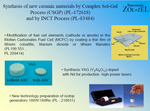The sol-gel Laboratory
The works on synthesis of modern ceramic materials by an application of a classical sol-gel method have been carried out since 40 years in the Sol-Gel Laboratory. Over the years, we have developed and patented our flagship methods – the ICHTJ method (ang. INCT Process) from the name of the Institute and the Complex Sol-Gel Process (CSGP), which are used in most of the research. The essence of the CSGP is the application of a complexing agent which includes ascorbic acid as a reducing agent. Ascorbic acid has properties which simplify the sol-gel process and improve the properties of ceramic materials. It has the ability to mix homogeneously with a given sol solution and does not cause an intensive reduction of metal ions under the process’ conditions. With its complexing properties, it facilitates the creation of a network of bonds in gels and stabilizes a metal cation by its complexation, which consecutively results in the reduction of its reactivity. In the case of synthesis of multicomponent systems and differences in the rate of hydrolysis, the substrate does not cause premature precipitation. Moreover, the application of ascorbic acid allows for obtaining hydroxyl-ascorbate sol solutions with practically all metal cations, even those with a Group 1 and 2 of the Periodic Table, which typically do not form hydroxyl sols. The method is also characterized by a high level of amorphousity of forming gel, its high wettability and adherence of sols. The obtained powders are also characterized by a very good sinterability, compared with the powders obtained by conventional sol-gel methods, as well as a wide range of obtainable shapes: irregular powders and spherical particles (including hollowed ones), layers on a variety of substrates, fibers or monoliths.
Ceramic materials received at the Laboratory are applied in energy, electronics, medical, automotive, construction and environmental protection, and include e.g.:
- high temperature ceramic superconductors - type YBCO and BSCCO and their modifications,
- bioceramic materials based on calcium phosphate (e.g. hydroxyapatite) e.g. as a layer on the hip endoprosthesis prepared by plasma spraying,
- positive electrode materials in high-energy-density lithium and lithium-ion batteries e.g. Li1Co1-yNiyO2. The original method for obtaining large (A4) porous Ni/NiO cathodes (for MCFC) coated with a protective layer of LiCoO2 and/or LiMg0,05Co0,95O2 has been elaborated.
- laser crystals doped Yb - KY(WO4)2, KY(WO4)2 + 1%mol Yb,
- Y2O3 microspheres as radiopharmaceutical precursor used in the treatment for liver cancer,
- and many others.
In recent years, research in the Laboratory has been mainly focused on the synthesis of ceramic materials for nuclear energy. The works in the framework of 7th European Framework Programme (EURATOM) - Advanced fuelS for Generation IV reActors: Reprocessing and Dissolution (ASGARD) were carried out and focused on:
- the development of physicochemical methods for fabrication of fuel for III+ and IV generation nuclear reactors;
- the development of technology for fabrication of spherical nuclear fuel - UO2 and UC - containing minor actinides, separated from spent nuclear fuel, for nuclear transmutation of long-lived isotopes into short-lived actinides in fast reactors (IV generation);
In the framework of the National Strategic Research Project Technologies supporting the development of safe nuclear energy the research were related to the theme:
- the development of production technology of sintered UO2 fuel in the classical form (pellets) and a spherical shape;
- the elaboration of chemical methods of production of mixed fuels’ precursors (MOX) and analysis of the possibilities of using various composition;
- the development of application technologies of separate elements from spent fuel to produce inert matrix (stabilized ZrO2) for the transmutation of long-lived fission products and actinides in fast reactors and accelerator driven systems (ADS);
- the development of modern methods for conditioning and solidification of radioactive waste, in the silica glass and ceramic matrices, based on titanium oxide;
- the development of application methods for separate elements from spent fuel, to produce fuel precursors for new-generation reactors - uranium fuel carbide and nitride.
The results of the introduced innovations to the sol-gel method, in particular of the Complex Sol-Gel Process (CSGP) and the ICHTJ process, are patents granted in Poland and other countries. 16 patents have been obtained in Poland and 9 in other countries (EU, Ukraine, Belarus, and Russia). Moreover, 8 following patent applications in Poland, and the 4 in other countries (France, Germany, United Kingdom) have been submitted and are waiting for approval.
The elaborated patented methods have been repeatedly awarded at the International Innovation Exhibition e.g. Eureka (Brussels), Archimedes (Moscow), Salon International Des Inventions de Geneve (Geneve), the International Warsaw Invention Show and others. Since the year 2000, the Sol-Gel Laboratory has received a total of 24 awards, including 7 gold, 3 silver, 5 bronze medals and 9 special awards.
Sol-Gel Laboratory team
Danuta Wawszczak, PhD – head of laboratory
e-mail :
tel: +48 22 504 12 56
Andrzej Deptuła, PhD – head of laboratory 1955-2014
e-mail :
tel: +48 22 504 11 56
Wiesława Łada, MSc
e-mail :
tel: +48 22 504 12 06
Tadeusz Olczak, MSc
e-mail :
tel: +48 22 504 11 58
Marcin Rogowski, MSc
e-mail :
tel: +48 22 504 10 54
Marcin Brykała, PhD – post-doc position in CEA Marcoule to 31.XII. 2016
e-mail :
tel: +48 22 504 12 72
Researchgate , LinkedIn
Tomasz Smoliński, MSc
e-mail :
tel: +48 22 504 11 38
Patryk Wojtowicz, MSc
e-mail :
tel: +48 22 504 11 38
Renata Laskowska
e-mail :
tel: +48 22 504 13 72
